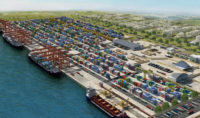Unfriendly Skies
Kenya Feuds With Chinese Contractor Over Cancelled Terminal Job
Greenfield Terminal contract was awarded in violation of RFP terms, Kenya Airports Authority claims.
Africa’s largest air freight service provider, Kenya Airports Authority, wants a $42-million refund from the Chinese joint venture of Anhui Construction Engineering Group and China Aero Technology International Corp. The JV received the advance payment as part of a $633-million construction contract for a greenfield terminal at the Jomo Kenyatta International Airport (JKIA).
KAA's demand claim was confirmed at a hearing of the Parliamentary Public Investment committee in early May. President Uhuru Kenyatta launch the greenfield terminal project in 2013 by but the contract was terminated in 2016.
KAA Managing Director Johnny Andersen and Kenya’s Cabinet Secretary for Transport James Macharia say the Chinese contractor must refund the advance payment because the contract was awarded illegally in violation of provisions in the Request for Proposal.
“I want the money paid to the contractor back,” Andersen told the committee.
Macharia added that the contractor “must reimburse what we paid them,” although he admitted negotiations are ongoing on how the refund should be made.
The contractor has made a counterclaim of $217 million for termination of the contract, which KAA says violated the requirements set out in the RFP. Sticking points include the Chinese firms’ decision to refer to foreign currencies in the construction contract and commencing construction work before financing was secured as spelled out in the RFP.
“This claim ($217M) has not been verified and my position as the custodian of KAA, who came in to clean this illegal contract is that the money already paid be reimbursed. But the contractor’s position is quite the opposite and therefore the need for negotiations,” Andersen told the members of the parliamentary committee.
The Kenyan government has, however, indicated financial pressure and surplus passenger handling capacity could have accelerated the termination of the project, which had been opposed from the initial stages by a section of the former administration under President Mwai Kibaki.
“Expansion and modernization of the existing terminals will offer capacity of up to 14 million passengers a year, which is the airport’s projection for 2025,” Macharia told a media briefing early this month.
He said Kenya is “looking at the cost of the project vis-à-vis the benefits and our financial obligations. What is important for JKIA is to make sure that current terminals are properly utilized. We have about five million passengers coming in every year but those terminals have got capacity of up to 12 million passengers.”
Kenya’s President Uhuru Kenyatta led a delegation to the Belt and Road Initiative forum in Beijing last month, but the airport was not one of the BRI projects.
In the last quarter of 2018, National Treasury’s Principal Secretary Kamau Thugge saidin a report “all new projects have been frozen until completion of ongoing ones in order to improve efficiency of our public investment, streamline spending and reduce wastage.”
By the time the JKIA Greenfield terminal project was launched in 2013, KAA was already constructing three other terminals and also remodeling and upgrading three more with capacity raise annual passenger handling capacity to 10 million by end of 2020.
Macharia said Kenya may in the future need the JKIA Greenfield terminal but for now “we do not need a new terminal but may in the future and when we do, the most likely option is the private sector to do it.”
The Greenfield Terminal, which was designed by Louis Berger & Pascall+Watson, would have increased the capacity at JKIA from the current 6 million passengers per year to about 18.5 by 2030 with Phase 1 of the GFT handling 12.7 million passengers, according to a project brief by the African Development Bank, the designated financier of the project.
In 2017, JKIA handled 7.61 million passengers and 313,000 tons of cargo, according to KAA reports.




